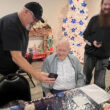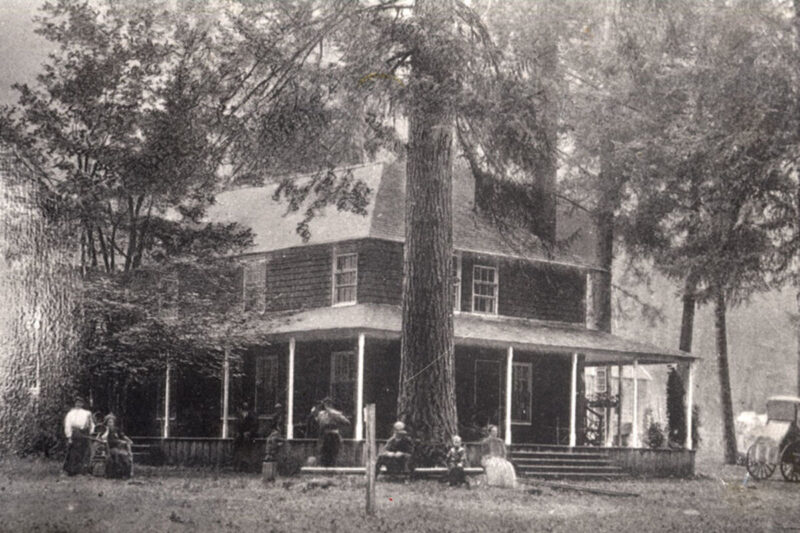Roberta McKern
“Which way?”
“I think that’s upside down.”
“Wait, something’s stuck in there.”
“Looks like a piece of cork.”
“It won’t shake loose.”
“No. I’ll see if I can get it. I think I can.”
Two lady volunteers at the East Linn Museum are attempting to figure out a small, tin object. A 2-inch-long handle bridges a trough at one end. With raised projections, the 3-inch trough sits within a 5-inch metal frame, with a handle that slides back and forth. Midway between the trough and where the handle fits on, a cylinder forms right angles. A rod runs up its center, attached to a small knob at the bottom and surrounded by a spring. Just below the “T” formed by the trough, a hole in the cylinder reveals the thing caught in it.
The ladies know what the object is. The label says “nutmeg grater.”
However, they’re not certain how it works. One sniffs what the other suggests might be cork. “Nutmeg,” she said, “Smell.”
Ah, a scent reminiscent of rice pudding. And what was left of the nut matched those in a nearby box with a cellophane window and the label “Crescent.”
It becomes somewhat clear how the grater operates. A nutmeg put through the window in the cylinder is held in place by its rod and the spring. The grater, traveling back and forth while suspended in the rectangular frame, does its job of chewing bits of the nut. These bits could be released from the cylinder by pulling down on the rod or maybe by shaking them out of the trough with its enclosed ends – or, where did they go out? Possibly they fell out the window??
Experiments of working the grater haven’t progressed, and so the nutmeg grater’s secrets are almost solved, but maybe not quite. No jeopardizing a museum artifact occurs.
There’s no telling how old the little nutmeg grater is or how long it has held onto its nutmeg.
Nutmegs have been highly regarded as spices for centuries, but we don’t know of tests made to see how long they retain the oils giving them flavor. Originally they came from the East Indies. Dutch colonists kept a strict monopoly on the nutmeg trade, but seeds and seedlings smuggled out and coaxed into growing in Caribbean islands called the West Indies made the spice more available.
Originally, many nutmeg graters reflected the nut’s value, often being made of gold or silver, sometimes ornately decorated. In later years, housewives relied on miniature graters of simple rectangular or cylindrical form. The mechanical one perplexing the two museum volunteers may be exceptional.
It sits in a darkened corner of the museum’s main room, and along with other gadgetry from the days of pre-electric kitchens, it can be easily overlooked. Among its companions are meat grinders, lard presses, a potato grater, a potato ricer, a vegetable mill and, across the way, an assortment of wooden churns.
When we look at them we think mainly of the end of the 19th century going into the 20th. They reflect a time when power in the kitchen came from the cook’s right arm, unless the cook was a lefty, because handles often had to be turned.
Today, coming across a real piece of nutmeg in its whole state is unusual. We forget how they were once a part of American folklore. In the spring, it was said, Yankee peddlers headed south to visit hill farms where women looked forward to seeing gewgaws and other small articles, including the well-scented nutmegs.
If they were scented – Yankee peddlers specialized, so it goes, in delivering nutmegs hand carved of good New England wood, and Yankee peddlers and wooden nutmegs both gained bad reputations. We might wonder if a wooden nutmeg was worth a wooden nickel?
The museum’s nutmeg grater bespeaks the transitory nature that befalls quotidian kitchen objects. “Quotidian” is an impressive word that means ordinary. We don’t get to use it often since, like the museum’s nutmeg grater, it is usually shelved. No longer used.
If we look in the next-door kitchen mock-up, leaving the nutmeg grater and main room, we can find a larger number of once-useful, now-abandoned kitchen gadgetry plus granite ware (agate, it was also called) and some cast iron ware.
Among gadgets, the museum boasts two cherry pitters, sometimes called cherry stoners. How they work isn’t surefire either, but with cherries selling at about three dollars a pound, no plans are being made to pit the differing machines against each other to see which works best.
We can find a lot of graniteware, the name given to steel or tin bodied objects coated with mottled enamel usually in shades of gray and black or blue and white. The gray and black especially resembles stone, assumably granite. The enamel imparted a smoother surface, less prone to rust and easier to clean. Hence, granite ware once enjoyed great popularity appearing as coffee urns, teapots, baking pans, ladles and dippers, colanders, cups, saucers, plates. about any thing workable as lightweight metal ware, including slop pots and chamber mugs.
We see, too, enamelware like some in white on the kitchen’s table which includes plates, mugs, a coffee pot and even a Jack-be-nimble candlestick holder but unless it is actually old, we don’t really come across graniteware anymore.
The same cannot be said of cast iron. It is old-fashioned, but not altogether obsolete. Solid and heavy, it still withstands the tests of time. Many of us rely on cast iron frying pans, well seasoned. Some like to bake in the varied pans made for rolls or corn bread, and Dutch ovens remain reliable although griddles may not now be made of cast iron like they used to be.
Which brings up a solved museum mystery regarding a griddle and three appendages. The narrow griddle forms one side. Hinged to it are three low pans, circular and about five inches wide to make the other half of the unit. It’s easy to guess we are talking pancakes and that somehow the pans fit on the griddle, but with what sequence?
The old 1897 Sears Roebuck catalog supplied the answer. With the contraption heating on the stove, pancake batter goes into the three pans. When this batter has baked on the bottom, the pans can be flipped onto the griddle with a fork. The cooking pancakes fall out and continue to bake on the griddle while more batter fills the trio of pans.
Behind the stove where the griddle sits, there is another cast iron utensil. Resembling a round griddle with three wells rising like a clover from it, it is an egg poacher. Make three poached eggs to top the pancakes and breakfast is ready! Maybe we’d prefer fried eggs, and frying pans also sit on the kitchen’s cast iron stove.
Iron frying pans and kettles can’t be separated from American history. Traders carried kettles to satisfy the Indian ladies who recognized their usefulness, miners swirled sand and water in fire blackened frying pans while seeking the color of gold and old frying pans have been found in abandoned logging camps.
Cast iron griddles are maybe a little rarer than pots and frying pans, but the large oval one seen along with the aforementioned griddle on the warming shelf of the museum’s stove did come from the hotel in Cascadia. We can also think much museum kitchen ware would fit right in with the hotel’s ambiance because the 1890s and early 20th century represented high points for both.
So here is part of the story of the Geisendorfer Hotel, our interest being mainly in the kitchen.
It starts with George Geisendorfer’s stomach troubles. They were so bad, he feared they would prove fatal. The family lived in Albany. Hearing of the curative powers of the soda springs at Lower Soda, as it was then called, George traveled to them. Camping out, he practiced a regimen of drinking the effervescent mineral impregnated water. Not only did he begin to feel better, he decided he was cured.
Soda springs and their healthful waters were much admired at the time and so it wasn’t too surprising for George to buy 200 acres, springs included, and to set up a resort.
Hunting and fishing added attraction to the area, and it was next to the Santiam toll road, which provided easy access. He built a hotel, which would grow to 32 rooms and include dining facilities for nearly 100 people. He also added a store and in time became the local postmaster.
Pasturage he also had, and so he added a horse barn big enough to accommodate 80 horses, if need be. He planted a vegetable garden, berry patches, fruit trees and beautiful flowers, becoming known particularly for lilies and dahlias.
His wife Jennie proved to be one his best assets. With sparkling dark blue Irish eyes and wit and humor she charmed many guests. She often enticed them into helping her in the kitchen, the hotel being her domain.
“As long as you’re here,” she might say to a guest visiting her kitchen, “you can help,” and a chore would be made evident. Sometimes it was shelling peas or snapping green beans. A hunter coming in to warm up could be urged to bring in an armful of wood.
According to an old Democrat-Herald article written by Doris Gunderson and stored in the museum’s files, Mrs. G or “Aunt Jen,” as she was called, did have the aid of at least two chamber maids who daily ran a gas-powered washing machine.
Too, at one time Lulu Rice worked at the hotel. Lulu Rice was a multiple marrying kind whose last name underwent an occasional change. Perhaps being a denizen of the hotel kitchen, swathed in an apron and smelling of fresh baked bread, enhanced her attractions. At any rate, Lulu remembered how it took 50 pounds of flour a day to satisfy the hotel’s baking demands.
An oven was built which could bake 50 loaves at a time, some of which they sold to regular customers and nearby campers. Maybe it was like that of the museum’s cast iron oven from Dollar Camp, the logging reloading center up the Calapooia.
Known also for her fruit pies, did Mrs. G. beguile a guest into cranking a cherry pitter or an apple parer? The Museum’s griddle, too, contributed to the production of pancakes. Plus there were biscuits, cakes and other good things.
One of Mrs. G’s favorite late- night snacks for guests consisted of ginger bread served with a layer of tapioca pudding further topped with whipped cream.
Meals at the hotel cost 50 cents. That seems a little high, because the going price for meals served at other stopping places along the Santiam toll road are generally given as being 25 cents. But at the hotel, the policy was “all you can eat.” And dyspeptics could drink of the spa’s natural soda water to cure their stomach troubles and improve their appetites.
As for the soda baths, by the way, each guest had free access to one bath a day, hot or cold. How the baths worked is unclear. Was it ladies here and gentlemen there in separate buildings? Did they bring bathing suits or sit in nature’s healing waters as nature had formed them? Propriety counted.
Eventually, George Geisen-dorfer sold the hotel to two investors who tore it and the barn big enough to hold 80 horses down, and much record of what the hotel was actually like does not seem to exist.
The investors failed and Geisendorfer received the Cascadia property back. However, times had changed. As a resort, the area became doomed by the arrival of the automobile, the end of the toll road and beginning of Highway 20 and the establishment by the government of free camping areas along the new highway.
In the early 1940s the area became Cascadia State Park.
If the griddle at the museum, which came from the hotel reminds us of past times, so too do the other over 100 pieces of kitchen ware and gadgetry. On the museum’s kitchen floor sits the pachyderm in the room, another mystery.
A long, hinged taffy cutter rests on its own cutting board. It may have come from a fleetingly mentioned confectionery shop which once existed in Sweet Home.
A large wooden pestle leans above it. Did it once mash a cauldron filled with boiled potatoes? Or did it, too, have something to do with candy making?
Little mysteries innumerable abound in the East Linn Museum, so do drop in and pique your curiosity. Or maybe you can supply answers.
We’re not certain the question of the nutmeg grater has been solved.





